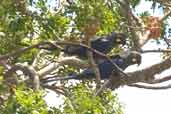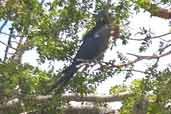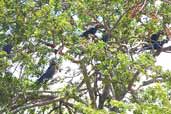|
Lear's Macaw Anodorhynchus
leari
(aka Indigo Macaw) |
 |
near
Jeremoabo, Bahia, Brazil
March 2004
The
Lear's Macaw is a Brazilian endemic
restricted to a very small area of caatinga in Bahia. It was only
rediscovered by ornithologists in 1978 and is still restricted to
a very small number. It is rated as Critically
Endangered by Birdlife International.
|
 |
It
feeds on licurí palm nuts, which are becoming scarcer with
the spread of ranching, and it requires sandstone cliffs for
nesting and roosting. These conditions are highly restrictive.
Add to this the pressure from the poachers and the smugglers who
try to supply the caged bird trade and it is surprising that
there are any birds left in the wild. |
 |
In 2000, the population was
estimated to be less than 150 birds but when we were there in
March 2004 we were told that this number had increased. This is
partly due to the ornithologists working on preserving the
species but I think a great deal of credit must go to the local
land-owners such as Sr. Otávio and José Hilton who
take such an obvious pride in their macaws.
The bird itself is like a smaller version
of Hyacinth Macaw
Anodorhynchus hyacinthinus but the blue is not so intense
and is tinged with green.
The species name comes from Edward Lear,
better known now for his Nonsense Poems but also a noted bird
illustrator who in 1830 published "Illustrations of the
family of Psittacidae or parrots".
|
|
|
|
|
|
|
|
|


